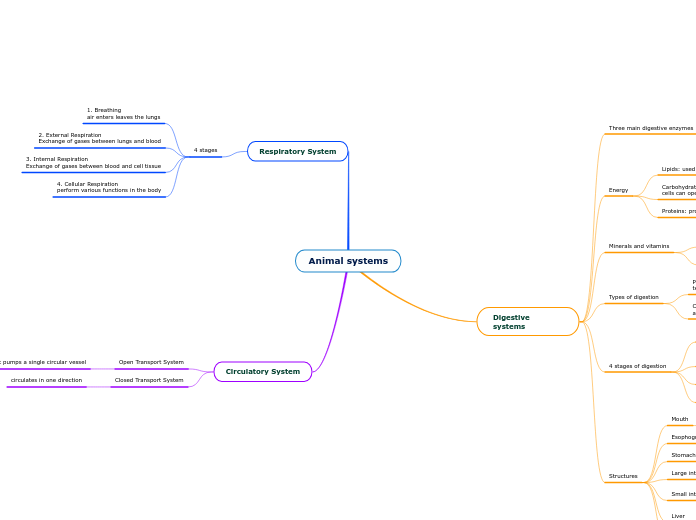Biological Molecules
Graphic Organizer
Proteins
Protein Diversity and Structure:
Protein-DNA Interactions: Proteins like transcription factors bind to DNA to regulate gene expression.
Protein Roles and Interactions
Protein Folding: Chaperone proteins help newly synthesized proteins fold correctly.
Protein Conformation: The specific three-dimensional shape of a protein is crucial for its function.
Protein Structure: Multiple polypeptide chains come together to form a protein with a quaternary structure (e.g., hemoglobin).
Enzyme Regulation and Interaction:
Protein Denaturation: Proteins can lose their shape (denature) due to factors like high heat, extreme pH, or chemicals.
Activation Energy: Enzymes lower the activation energy required for chemical reactions to occur.
Molecules like vitamins can act as coenzymes and assist enzymes in catalyzing reactions.
Protein Structure and Function:
Enzyme-Substrate Complex: The temporary binding of an enzyme and its substrate forms an enzyme-substrate complex, facilitating chemical reactions.
Lock-and-Key Model: Describes enzyme-substrate interaction as a specific fit, much like a lock and key.
Enzymes are highly specific, recognizing only certain substrates based on their shape and chemical properties.
Carbohydrates
Digestion and Health Implications:
Lactose Intolerance: Inability to digest lactose (milk sugar) results from a deficiency of the enzyme lactase and can lead to digestive discomfort.
Cellulose Digestion: Humans lack the enzymes required to digest cellulose, but it serves as dietary fiber.
Digestion: Carbohydrates are broken down into simpler sugars, like glucose, during the digestion process.
Biological and Functional Aspects:
Sweetness: Different sugars vary in sweetness, with fructose being sweeter than glucose.
The glycemic index measures how quickly carbohydrates raise blood sugar levels, with high-GI foods causing rapid spikes.
Glycoproteins: Carbohydrate chains attached to cell surface proteins (glycoproteins) are vital for cell recognition and communication.
Hydrophilic Nature: Carbohydrates are hydrophilic, making them soluble in water.
Carbohydrate Bonding and Complexity:
Polysaccharide Varieties: Polysaccharides can be branched or unbranched, serving various functions (e.g., cellulose for structure, glycogen for energy storage).
Monosaccharide Diversity: Besides glucose and fructose, numerous other monosaccharides exist, including ribose, deoxyribose, and mannose.
Disaccharide Formation: Disaccharides form when two monosaccharides join through a glycosidic bond.
Monosaccharide Properties:
Shape in Solution: Carbohydrates can take on helical or linear shapes based on their specific molecular structure.
Isomers: Glucose and galactose are isomers, sharing the same molecular formula but having different structures.
Monosaccharide Structure: Monosaccharides often adopt ring forms in aqueous solutions due to their tendency to form cyclic structures.
Water
Biological
Significance
Hydration: Proper hydration with water is essential for maintaining bodily functions and preventing dehydration.
Role in Ecosystems: Surface water bodies, such as oceans, lakes, and rivers, play significant roles in the Earth's climate, ecosystems, and as valuable resources for human activities.
Thermal Regulation: Water plays a crucial role in regulating temperature in organisms through processes like sweating and evaporative cooling.
Lubrication: Water provides lubrication for joints and body cavities in animals, facilitating smooth movement and reducing friction.
Transport Medium: In organisms, water serves as a medium for transporting essential nutrients, gases, and waste products.
Chemical
Characteristics
Ionization: Water molecules can ionize into H+ (hydrogen ions) and OH- (hydroxide ions), serving as the basis for measuring acidity and alkalinity on the pH scale.
Thermal
Properties
Heat Capacity: Water has a high specific heat capacity, meaning it can absorb and store a significant amount of heat without significant temperature changes. This property helps stabilize temperatures in living environments.
Heat of Vaporization: Water requires a substantial amount of heat energy to change from a liquid to a gas, making it essential for cooling mechanisms like sweating in animals.
Phase Transitions: Water exists in three phases under normal conditions: solid (ice), liquid (water), and gas (water vapor).
Density Anomaly: Water is densest at 4°C, causing ice to float on water. This property is vital for insulating bodies of water and preventing complete freezing in aquatic ecosystems.
Water's Unique
Properties
Hydrogen Bonding: Water molecules are held together by hydrogen bonds, forming between the positively charged hydrogen atoms of one molecule and the negatively charged oxygen atoms of another
Cohesion: Water molecules are attracted to each other due to hydrogen bonding, resulting in high cohesion and surface tension.
Adhesion: Water molecules can adhere to other substances due to their polarity, allowing them to climb against gravity in narrow tubes through capillary action.
Universal Solvent: Water is often referred to as the "universal solvent" because it can dissolve a wide range of substances due to its polarity.
Cellular Structure
Although the size of a cell is very small. The cell does a lot of things for living things to function.
Technology
Tools like electron microscopes reveal cellular details.
Choice of technology depends on structure size.
Understanding Sizes
Cells have various components with different sizes.
An interactive tool helps visualize object sizes.
Metric prefixes help calculate relative sizes.
Cells are the basic units of life, categorized as prokaryotic or eukaryotic.
Nucleic Acids
Adenosine Triphosphate (ATP):
Composed of three phosphate groups, one ribose (sugar), and one nitrogen base.
Dehydration synthesis of ATP from ADP + P requires energy (endergonic reaction).
Hydrolysis of ATP to ADP + P releases energy (exergonic reaction).
DNA and RNA
RNA:
Single-stranded helix.
Composed of ribose sugar.
Nitrogen bases: adenine, guanine, cytosine, uracil.
DNA:
Double-stranded helix.
Composed of deoxyribose sugar.
Nitrogen bases: adenine, cytosine, guanine, thymine.
Nucleotides
Composed of sugar, phosphate group, and nitrogen base (adenine (A), thymine (T), guanine(G), cytosine(C))
Monomer unit for all Nucleic Acids
Types of Nucleic Acids and Genetic Information:
Includes DNA, RNA and Adenosine Triphosphate (ATP)
ATP:Created in the mitochondria and is used as energy in the cell
RNA: Involved in making proteins
DNA: makes up genetic material and makes instructions for proteins
Lipids
Lipid Digestion and Membrane Fluidity:
Lipid Bilayer Fluidity: The fluidity of cell membranes is influenced by the types of lipids present and their degree of saturation.
Lipid Digestion: Enzymes like lipase break down dietary fats into fatty acids and glycerol.
Fat-Soluble Pigments: Lipids can carry fat-soluble pigments
Lipid Properties and Storage:
Lipid Hormones: Lipids, such as steroids, serve as hormones (e.g. sex hormones).
Lipid Solubility: Lipids are nonpolar and hydrophobic, making them insoluble in water.
Lipid Storage: Adipose tissue stores excess energy in the form of triglycerides.
Types and Functions:
HDL vs. LDL Cholesterol: High-Density Lipoprotein (HDL) is considered "good" cholesterol, while Low-Density Lipoprotein (LDL) is "bad" cholesterol.
Phospholipid Bilayer: Phospholipids arrange themselves in a bilayer in cell membranes due to their amphipathic nature.
Fatty Acids and Structure
Cis vs. Trans Fats: Cis fats have hydrogen atoms on the same side of the double bond, while trans fats have them on opposite sides, and they are often considered unhealthy.
Fatty Acid Variability: Fatty acids can vary in length (number of carbon atoms) and saturation (presence of double bonds).









